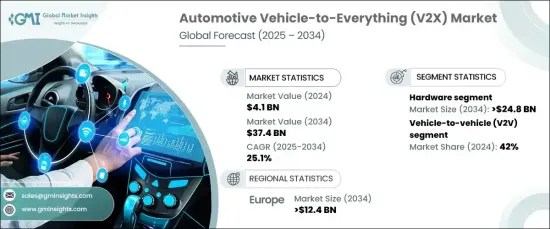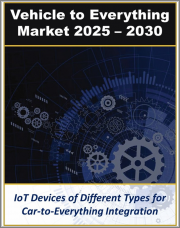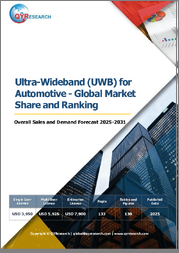
|
시장보고서
상품코드
1666604
자동차 V2X 시장 기회, 성장 촉진요인, 산업 동향 분석, 예측(2025-2034년)Automotive Vehicle-To-Everything (V2X) Market Opportunity, Growth Drivers, Industry Trend Analysis, and Forecast 2025 - 2034 |
||||||
세계 자동차 V2X 시장은 2024년 41억 달러로 평가되며 2025년부터 2034년까지 연평균 25.1%의 성장률을 보일 것으로 전망됩니다. 이러한 성장의 주요 원인은 교통 안전 강화에 대한 수요 증가와 자율주행 기술의 발전에 기인합니다. 각국 정부가 교통 안전 기준을 강화하고 스마트 교통 시스템 개발을 추진하면서 커넥티드 차량 시스템의 통합이 확산되고 있습니다. 차량, 인프라, 보행자 간 실시간 통신을 가능하게 하는 5G 네트워크의 구축도 교통 효율성, 안전성, 도시 이동성 향상에 중요한 역할을 하고 있습니다.

스마트 시티의 부상과 도시 인프라의 변화는 커넥티드 차량 기술의 채택을 더욱 가속화시키고 있습니다. 지속가능한 교통 솔루션에 대한 요구는 도시화의 진전과 함께 지능형 교통 관리 시스템, 전기자동차(EV) 충전소, V2X 지원 인프라에 대한 투자를 촉진하고 있습니다. 이러한 기술 혁신은 보다 원활한 교통 흐름을 만들고, 배출가스를 줄이고, 공공안전을 강화하는 것을 목표로 하고 있으며, 전체 시장 성장에 기여하고 있습니다.
| 시장 범위 | |
|---|---|
| 시작 연도 | 2024년 |
| 예측 연도 | 2025-2034년 |
| 시작 금액 | 41억 달러 |
| 예상 금액 | 374억 달러 |
| CAGR | 25.1% |
시장은 구성요소별로 하드웨어와 소프트웨어로 분류되며, 2024년 시장 점유율은 하드웨어가 64%를 차지했습니다. 하드웨어 부문은 크게 성장하여 2034년까지 248억 달러를 창출할 것으로 예상됩니다. 고성능 센서, 안테나, 차량 탑재 장치와 같은 하드웨어의 주요 발전은 차량과 인프라 간의 실시간 통신에 필요한 연결성과 데이터 처리 능력을 향상시키고 있습니다. 멀티밴드 안테나와 엣지 컴퓨팅 기술의 도입으로 보다 효율적인 데이터 교환이 가능해졌고, 칩셋과 모듈의 비용 절감으로 승용차와 상용차 모두에서 이러한 솔루션을 쉽게 사용할 수 있게 되었습니다.
V2X 시장의 통신 기술도 진화하고 있으며, 차량-차량(V2V), 차량-차량 인프라(V2I), 차량-차량-보행자(V2P) 등의 부문이 있습니다. 이 중 V2V 통신이 가장 큰 비중을 차지하며 2024년 시장의 42%를 차지했으며, 5G 및 C-V2X와 같은 저지연 통신 기술의 개발은 V2V 시스템의 채택을 가속화하여 충돌 방지 및 협업 운전과 같은 작업을 위한 실시간 데이터 공유를 용이하게 하고 있습니다. 이러한 기술들은 보다 안전하고 효율적인 도로를 실현하기 위한 토대를 마련하고, 궁극적으로 완전 자율주행 차량으로의 전환을 지원할 것입니다.
유럽의 차량 간 통신(V2X) 시장은 2024년 34%의 점유율을 차지했습니다. 이 지역은 첨단 자동차 부문과 지능형 교통 시스템에 대한 정부의 강력한 지원으로 인해 괄목할 만한 성장세를 보이고 있으며, 5G 인프라와 자율주행 기술에 대한 투자는 시장 확대를 더욱 촉진하여 유럽을 커넥티드 모빌리티로의 세계 전환에 있어 주요 기업으로 자리매김하고 있습니다.
목차
제1장 조사 방법과 조사 범위
- 조사 설계
- 조사 접근법
- 데이터 수집 방법
- 기본 추정과 계산
- 기준 연도 산출
- 시장 추정의 주요 동향
- 예측 모델
- 1차 조사와 검증
- 1차 소스
- 데이터 마이닝 소스
- 시장 정의
제2장 주요 요약
제3장 업계 인사이트
- 생태계 분석
- 공급업체 상황
- 원자재 프로바이더
- 기술 프로바이더
- 소프트웨어 프로바이더
- 시스템 통합사업자
- OEM
- 통신 프로바이더
- 최종 용도
- 이익률 분석
- 기술과 혁신 전망
- 특허 분석
- 주요 뉴스와 이니셔티브
- 규제 상황
- 기술 차별화 요인
- 통신 프로토콜
- AI와 머신러닝의 통합
- 사이버 보안
- 영향요인
- 성장 촉진요인
- 초고신뢰성 접속을 가능하게 하는 5G의 진보
- V2X 채용을 추진하는 정부의 안전 의무화
- 스마트 시티 개발을 추진하는 도시화 진전
- 자율주행차와 전기자동차의 급성장
- 업계의 잠재적 리스크·과제
- 보급을 늦추는 높은 인프라 비용
- 데이터와 차량 안전을 위협하는 사이버 보안의 취약성
- 성장 촉진요인
- 성장 가능성 분석
- Porters 분석
- PESTEL 분석
제4장 경쟁 구도
- 소개
- 기업 시장 점유율 분석
- 경쟁 포지셔닝 매트릭스
- 전략 전망 매트릭스
제5장 시장 추정과 예측 : 연결성별, 2021-2034년
- 주요 동향
- 전용 근거리 통신(DSRC)
- 셀룰러 차차간 통신(C-V2X)
제6장 시장 추정과 예측 : 차량별, 2021-2034년
- 주요 동향
- 승용차
- 세단
- SUV
- 해치백
- 기타
- 상용차
- 소형 상용차(LCV)
- 대형 상용차(HCV)
제7장 시장 추정과 예측 : 통신별, 2021-2034년
- 주요 동향
- 차량간 통신(V2V)
- 차차간(V2I)
- 차량 대 보행자(V2P)
- 기타
제8장 시장 추정과 예측 : 구성요소별, 2021-2034년
- 주요 동향
- 하드웨어
- 소프트웨어
제9장 시장 추정과 예측 : 용도별, 2021-2034년
- 주요 동향
- 플릿 관리
- 자율주행
- 충돌 회피
- 지능형 교통 시스템
- 주차장 관리 시스템
- 기타
제10장 시장 추정과 예측 : 지역별, 2021-2034년
- 주요 동향
- 북미
- 미국
- 캐나다
- 유럽
- 영국
- 독일
- 프랑스
- 스페인
- 이탈리아
- 러시아
- 북유럽
- 아시아태평양
- 중국
- 인도
- 일본
- 한국
- 뉴질랜드
- 동남아시아
- 라틴아메리카
- 브라질
- 멕시코
- 아르헨티나
- 중동 및 아프리카
- UAE
- 남아프리카공화국
- 사우디아라비아
제11장 기업 개요
- Aptiv
- Autotalks
- Bosch
- Cohda Wireless
- Commsignia
- Continental
- Denso
- Ficosa
- Harman
- Huawei
- Infineon
- Kapsch TrafficCom
- NXP Semiconductors
- Qualcomm
- Visteon
The Global Automotive V2X Market reached USD 4.1 billion in 2024 and is projected to experience a CAGR of 25.1% during 2025-2034. This growth is primarily driven by the increasing need for enhanced road safety and the ongoing advancements in autonomous driving technologies. As governments push for stricter traffic safety standards and the development of smart transportation systems, the integration of connected vehicle systems is becoming more widespread. The rollout of 5G networks, enabling real-time communication between vehicles, infrastructure, and pedestrians, is also playing a crucial role in improving traffic efficiency, safety, and urban mobility.

The rise of smart cities and the ongoing transformation of urban infrastructure are further accelerating the adoption of connected vehicle technologies. The need for sustainable transportation solutions, coupled with the growing trend of urbanization, is driving investments in intelligent traffic management systems, electric vehicle (EV) charging stations, and V2X-enabled infrastructure. These innovations aim to create smoother traffic flows, reduce emissions, and enhance public safety, contributing to the overall growth of the market.
| Market Scope | |
|---|---|
| Start Year | 2024 |
| Forecast Year | 2025-2034 |
| Start Value | $4.1 Billion |
| Forecast Value | $37.4 Billion |
| CAGR | 25.1% |
The market is categorized by component into hardware and software, with hardware accounting for 64% of the market share in 2024. The hardware segment is projected to grow substantially, generating USD 24.8 billion through 2034. Key advancements in hardware, such as high-performance sensors, antennas, and onboard units, are enhancing the connectivity and data processing capabilities necessary for real-time communication between vehicles and infrastructure. The incorporation of multi-band antennas and edge computing technologies is driving more efficient data exchange, while cost reductions in chipsets and modules are making these solutions more accessible for both passenger and commercial vehicles.
Communication technologies within the V2X market are also evolving, with segments such as vehicle-to-vehicle (V2V), vehicle-to-infrastructure (V2I), vehicle-to-pedestrian (V2P), and others. Among these, V2V communication holds the largest share, accounting for 42% of the market in 2024. The development of low-latency communication technologies like 5G and C-V2X is accelerating the adoption of V2V systems, facilitating real-time data sharing for tasks like collision avoidance and cooperative driving. These technologies are laying the groundwork for safer, more efficient roads, ultimately supporting the shift toward fully autonomous vehicle operations.
Europe automotive vehicle-to-everything (V2X) market accounted for a 34% share in 2024. This region is seeing significant growth due to its advanced automotive sector and strong governmental support for intelligent transportation systems. Investments in 5G infrastructure and autonomous driving technologies are further driving market expansion, positioning Europe as a key player in the global shift towards connected mobility.
Table of Contents
Chapter 1 Methodology & Scope
- 1.1 Research design
- 1.1.1 Research approach
- 1.1.2 Data collection methods
- 1.2 Base estimates and calculations
- 1.2.1 Base year calculation
- 1.2.2 Key trends for market estimates
- 1.3 Forecast model
- 1.4 Primary research & validation
- 1.4.1 Primary sources
- 1.4.2 Data mining sources
- 1.5 Market definition
Chapter 2 Executive Summary
- 2.1 Industry 360º synopsis, 2021 - 2034
Chapter 3 Industry Insights
- 3.1 Industry ecosystem analysis
- 3.2 Supplier landscape
- 3.2.1 Raw material providers
- 3.2.2 Technology providers
- 3.2.3 Software providers
- 3.2.4 System integrators
- 3.2.5 OEM
- 3.2.6 Telecommunication providers
- 3.2.7 End Use
- 3.3 Profit margin analysis
- 3.4 Technology & innovation landscape
- 3.5 Patent analysis
- 3.6 Key news & initiatives
- 3.7 Regulatory landscape
- 3.8 Technology Differentiators
- 3.8.1 Communication Protocols
- 3.8.2 AI and Machine Learning Integration
- 3.8.3 Cybersecurity
- 3.9 Impact forces
- 3.9.1 Growth drivers
- 3.9.1.1 Advancement of 5G enabling ultra-reliable connectivity
- 3.9.1.2 Government safety mandates pushing V2X adoption
- 3.9.1.3 Increasing urbanization driving smart city development
- 3.9.1.4 Rapid growth of autonomous and electric vehicles
- 3.9.2 Industry pitfalls & challenges
- 3.9.2.1 High infrastructure costs slowing widespread deployment
- 3.9.2.2 Cybersecurity vulnerabilities risk data and vehicle safety
- 3.9.1 Growth drivers
- 3.10 Growth potential analysis
- 3.11 Porter’s analysis
- 3.12 PESTEL analysis
Chapter 4 Competitive Landscape, 2024
- 4.1 Introduction
- 4.2 Company market share analysis
- 4.3 Competitive positioning matrix
- 4.4 Strategic outlook matrix
Chapter 5 Market Estimates & Forecast, By Connectivity, 2021 - 2034 ($Bn)
- 5.1 Key trends
- 5.2 Dedicated short-range communications (DSRC)
- 5.3 Cellular vehicle-to-everything (C-V2X)
Chapter 6 Market Estimates & Forecast, By Vehicle, 2021 - 2034 ($Bn)
- 6.1 Key trends
- 6.2 Passenger vehicle
- 6.2.1 Sedan
- 6.2.2 SUV
- 6.2.3 Hatchback
- 6.2.4 Others
- 6.3 Commercial vehicle
- 6.3.1 Light Commercial Vehicle (LCV)
- 6.3.2 Heavy Commercial Vehicle (HCV)
Chapter 7 Market Estimates & Forecast, By Communication, 2021 - 2034 ($Bn)
- 7.1 Key trends
- 7.2 Vehicle-to-vehicle (V2V)
- 7.3 Vehicle-to-infrastructure (V2I)
- 7.4 Vehicle-to-pedestrian (V2P)
- 7.5 Others
Chapter 8 Market Estimates & Forecast, By Component, 2021 - 2034 ($Bn)
- 8.1 Key trends
- 8.2 Hardware
- 8.3 Software
Chapter 9 Market Estimates & Forecast, By Application, 2021 - 2034 ($Bn)
- 9.1 Key trends
- 9.2 Fleet management
- 9.3 Autonomous driving
- 9.4 Collision avoidance
- 9.5 Intelligent traffic system
- 9.6 Parking management systems
- 9.7 Others
Chapter 10 Market Estimates & Forecast, By Region, 2021 - 2034 ($Bn)
- 10.1 Key trends
- 10.2 North America
- 10.2.1 U.S.
- 10.2.2 Canada
- 10.3 Europe
- 10.3.1 UK
- 10.3.2 Germany
- 10.3.3 France
- 10.3.4 Spain
- 10.3.5 Italy
- 10.3.6 Russia
- 10.3.7 Nordics
- 10.4 Asia Pacific
- 10.4.1 China
- 10.4.2 India
- 10.4.3 Japan
- 10.4.4 South Korea
- 10.4.5 ANZ
- 10.4.6 Southeast Asia
- 10.5 Latin America
- 10.5.1 Brazil
- 10.5.2 Mexico
- 10.5.3 Argentina
- 10.6 MEA
- 10.6.1 UAE
- 10.6.2 South Africa
- 10.6.3 Saudi Arabia
Chapter 11 Company Profiles
- 11.1 Aptiv
- 11.2 Autotalks
- 11.3 Bosch
- 11.4 Cohda Wireless
- 11.5 Commsignia
- 11.6 Continental
- 11.7 Denso
- 11.8 Ficosa
- 11.9 Harman
- 11.10 Huawei
- 11.11 Infineon
- 11.12 Kapsch TrafficCom
- 11.13 NXP Semiconductors
- 11.14 Qualcomm
- 11.15 Visteon



















